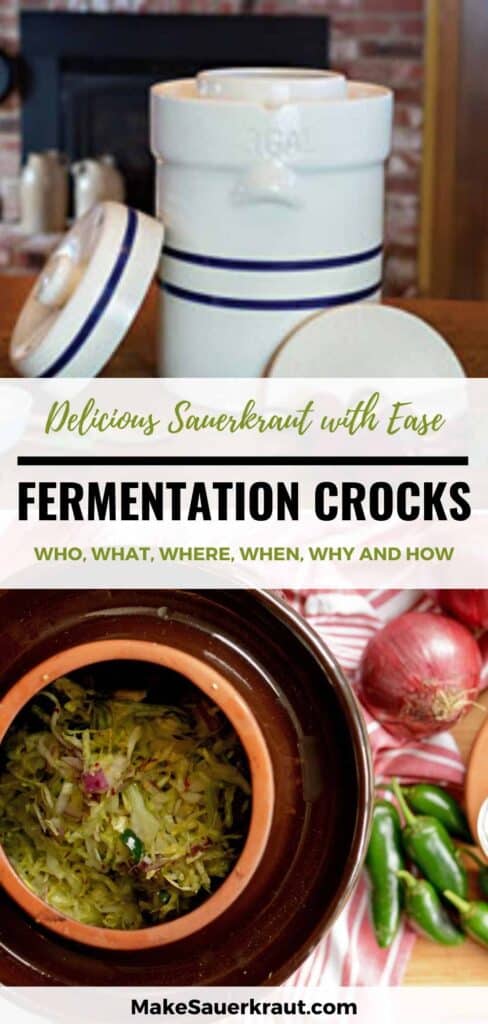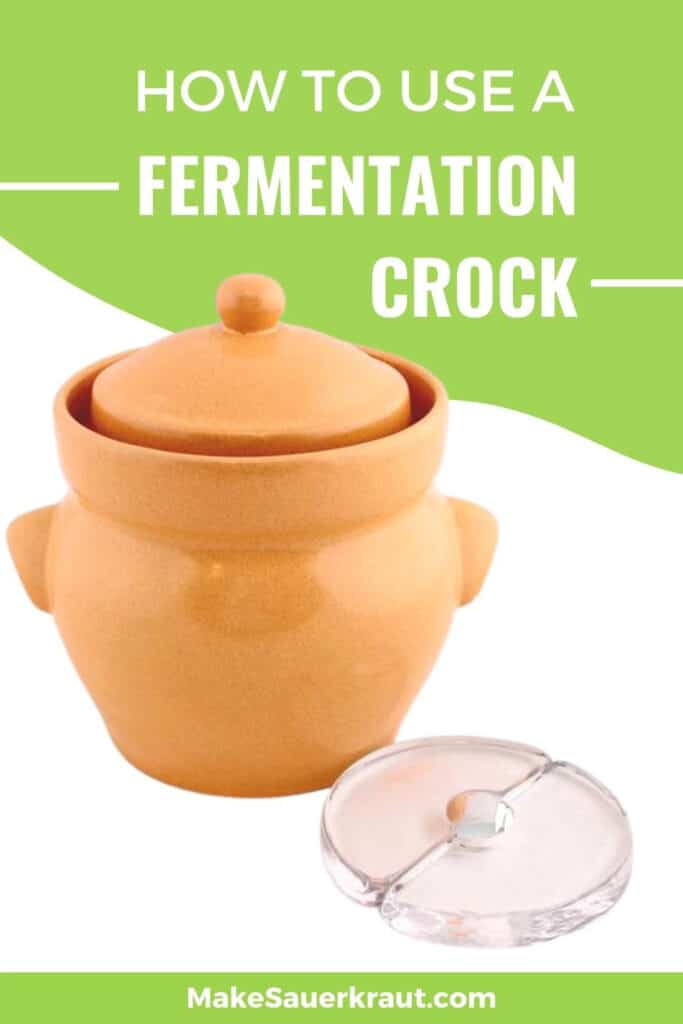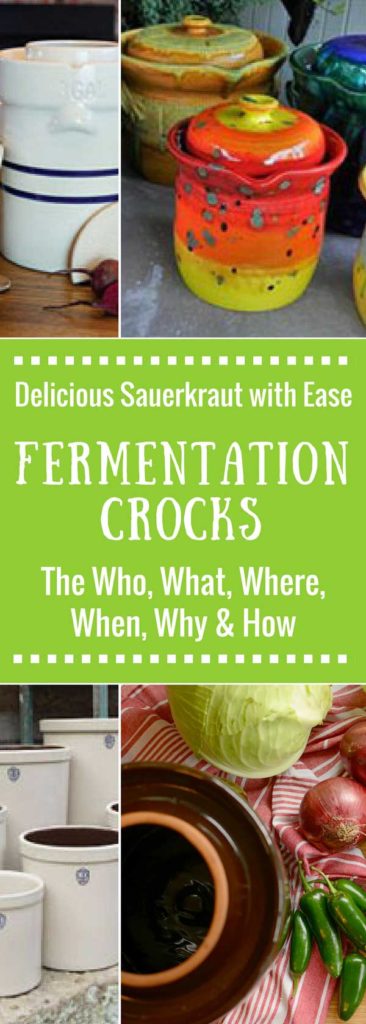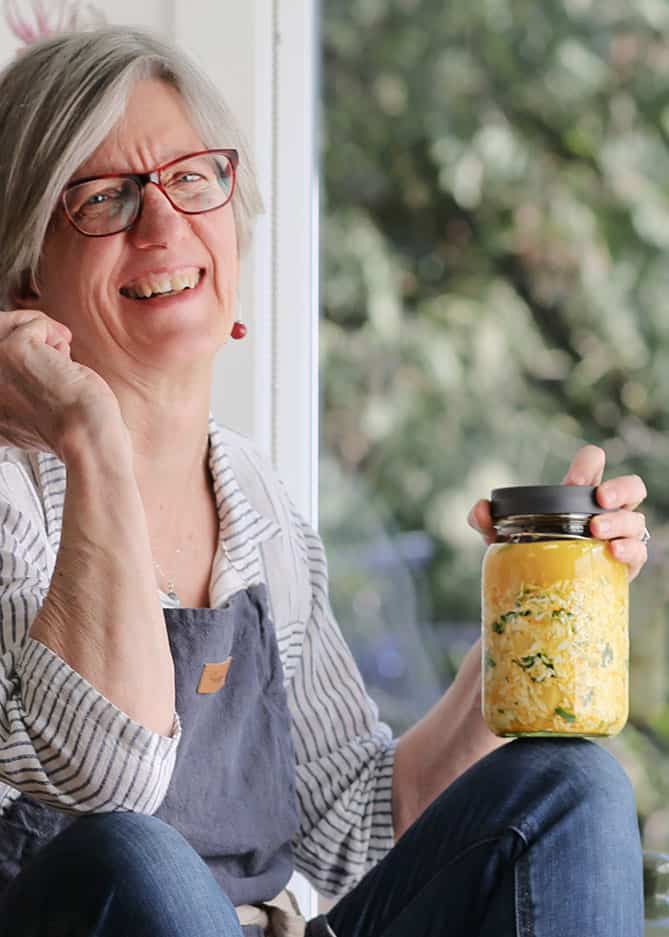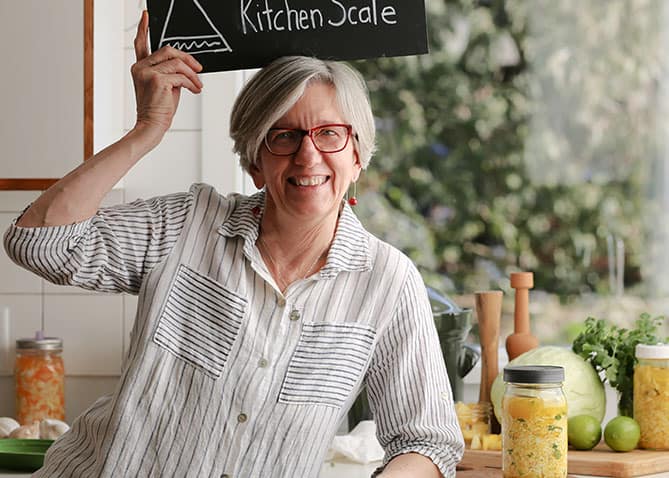Are you looking to ferment some pickles or sauerkraut in a stoneware crock, perhaps like that classic one that you might recall seeing in your grandparents’ basement? Let’s dive into the essentials of choosing and using the perfect fermentation crock!
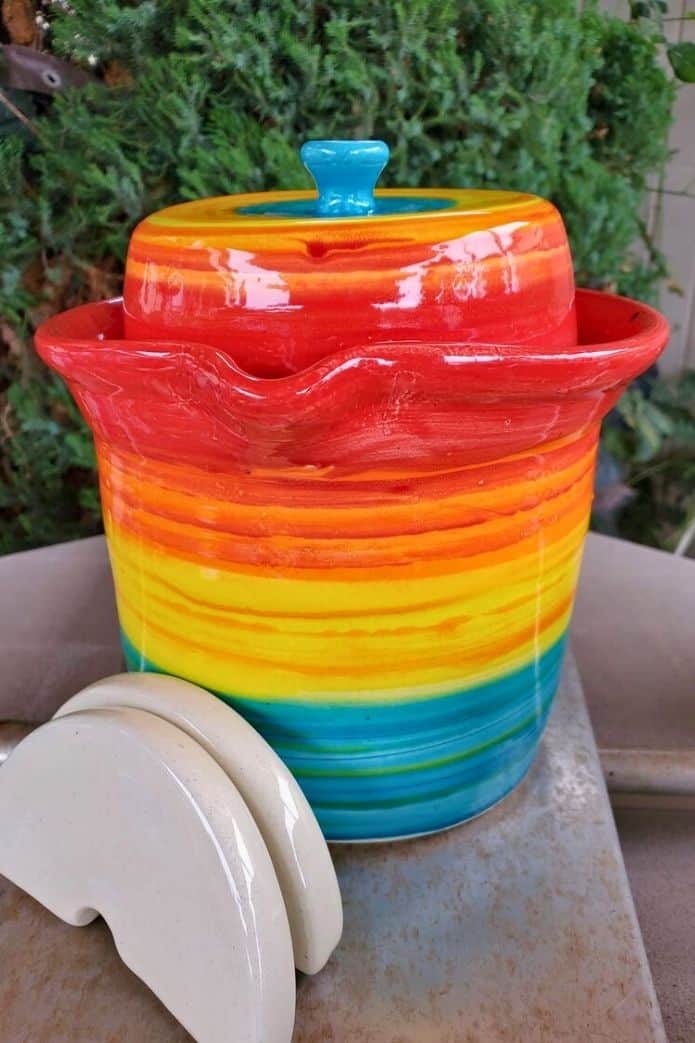
Do you want to know what size fermentation crock to buy?
Or, whether to buy the one with a funny-looking water moat around the top edge?
And, are there advantages to fermenting in a crock instead of a jar?
In this post, we’ll explore the ins and outs of fermentation crocks.
We’ll cover the different types of crocks, including open crocks and water-sealed crocks, and their respective advantages and disadvantages.
You’ll learn why using a water-sealed crock might be better than jars, who should use them, and what size to purchase.
We’ll also point you to where you can buy these crocks, from Amazon to artisan-made options.
Read on for the Who, What, Where, Why, and How of buying and caring for your water-sealed fermentation crock, one of my recommended items for home fermentation along with these favorite tools.
Then, when your beautiful, new, water-sealed crock has arrived at your home, grab my How to Make Sauerkraut In a Crock in 7 Simple Steps [Healthy, Flavorful, Easy] recipe.
- WHAT is a Fermentation Crock?
- WHY Use a Water-Sealed Fermentation Crock Instead of Jars?
- WHO Should Use a Water-Sealed Fermentation Crock?
- WHAT Size Fermentation Crock to Purchase?
- WHERE to Buy Water-Sealed Fermentation Crocks?
- WHEN to Ferment in a Crock
- HOW to Care for Your Crock
WHAT is a Fermentation Crock?
A fermentation crock is a vessel designed to hold cabbage and vegetables as they ferment. They vary in size all the way from 1-2 quarts (liters) up to 45 quarts (liters).
A large crock—vs. a small canning jar—is great for efficiently making large batches of sauerkraut or other fermented vegetables.
Typically, they are ceramic but can also be made from glass.
There are two primary types of ceramic crocks for fermentation available: Open Crocks and Water-Sealed Crocks. Both have advantages and disadvantages.
Open Crock
To ferment in an open crock, cabbage or vegetables are first packed into the crock and then a plate is placed in the crock—to hold whatever is fermenting below the brine.
Next, some type of weight (a large can or a jug filled with water) is placed on top of the plate. Lastly, a cloth is secured over the opening. With this set-up, the pickles or sauerkraut are packed under the brine but outside air can still enter the crock.
Advantages of an Open Crock
- Generally, less expensive than a water-sealed crock and readily available.
- Open top and straight walls make it easy to clean.
- Easy to fit whole or large vegetables into.
Disadvantages of an Open Crock
- Ferment is prone to developing surface mold and/or Kahm yeast (a harmless yeast that appears when a ferment is exposed to air).
- Older crocks may contain glazes unsafe for food use, especially crocks from Mexico.
- Weights and lids often need to be purchased separately and can dramatically raise the cost of the crock.
- If a cloth is used to cover your ferment, it’s prone to wicking brine onto the floor.
- Easy for flies and fruit flies to get into and lay eggs in (not a welcome gift in your ferment).
- Makes for a frustrating fermentation experience (Just read the Comment section on my most popular post, Has Your Fermentation Gone Bad?).
What About Fermenting in a Food-Grade Plastic Bucket?
A plastic bucket is a type of open crock. Not only are you allowing mold and other potentially harmful bacteria—as discussed above—to enter, but the acids produced during fermentation can react with the material in the bucket and leach harmful chemicals into your ferment. Even with BPA-free plastic, other chemicals in the plastic could leach into your foods.
Water-Sealed Crock

A water-sealed crock is the ONLY style fermentation crock I will ferment in! Biases aside…
Unlike when I first started fermenting, water-sealed crocks are now easy to find and can be beautiful pieces of art worthy of living on your kitchen counter.
A water-sealed crock is packed just as you would an open crock. Then, two half-circle weights (normally supplied with the crock) are placed on top of your packed vegetables to keep them submerged in the brine.
Next, the lid is placed into an open moat which is then filled with water. This setup allows carbon dioxide gases created during fermentation to easily bubble out and prevents outside air from entering the crock.
My wife and I are now believers in water-sealed crocks

Mike
We opened our first, water-sealed crock batch of sauerkraut today. Came out beautifully clear, so my wife and I are now believers in the method over our old school “pillowcase over the open crock”. We sealed it on the first day and never looked again. This was a TSM Fiesta Harvest 15 liter.
Advantages of a Water-Sealed Crock
- Makes for a very easy, almost carefree fermentation experience (You have to keep the moat filled with water.).
- Neither flies nor fruit flies can get into the crock and lay eggs.
- Very little chance of mold or surface yeasts growing on your ferment.
Disadvantages of a Water-Sealed Crock
- The water in the moat must be monitored and filled as necessary. If not, the seal will be broken and air will be allowed to flow into the crock.
- Due to pressure fluctuations, the water in the moat can get pulled to the interior of the moat, making it look like the moat is dry. Adding water to the moat in this situation causes it to flow into the crock and dilute the brine.
- A narrower opening makes it more difficult to pack your ferment.
- The shape at the top of the crock, where the lid is, can make it difficult to clean.
- The sealed environment makes it hard to monitor what is going on inside.
- Generally, more expensive than an open crock.
WHY Use a Water-Sealed Fermentation Crock Instead of Jars?
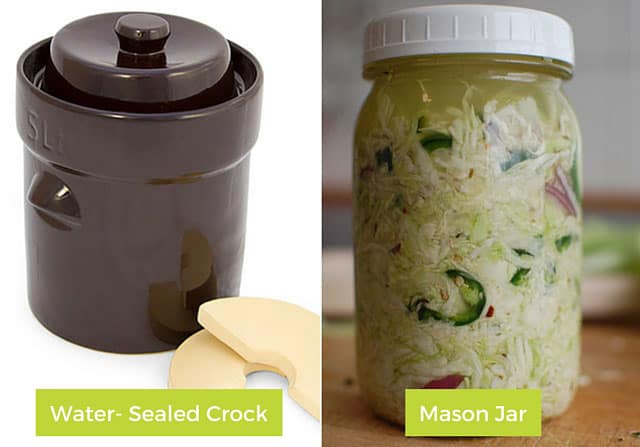
Now that you understand the differences between open crocks and water-sealed crocks for fermentation, I’ll share with you the advantages of fermenting in a water-sealed crock over a mason jar.
I am all for fermenting in mason jars, recommend their use for making various pickles or sauerkraut, and ferment about a third of our family’s annual supply of sauerkraut in jars.
My teaching recipe, How to Make Sauerkraut In a Jar [THE COMPLETE GUIDE] uses mason jars for a fermentation vessel.
Learning to ferment by using a one-quart (liter) glass canning jar makes fermentation a very doable task and allows for quick success and immediate feedback on whether you’re using the right amount of salt, keeping your ferment under the brine, and what flavors of sauerkraut you prefer.
However, once you’re comfortable with fermenting in a jar and want to make larger batches or just want the greater depth of flavor that develops in the more stable environment of a stoneware crock, I recommend graduating to fermenting in a water-sealed crock.
Advantages of Fermenting in a Water-Sealed Crock
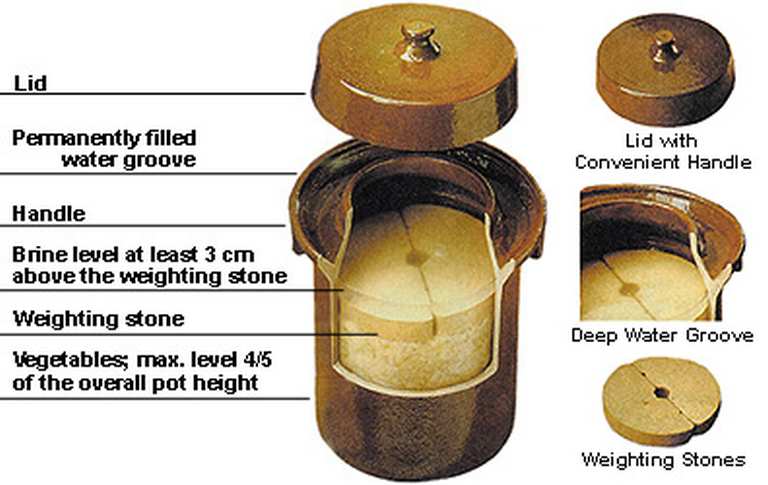
- The thicker stoneware wall creates a more stable and cooler fermentation temperature, resulting in sauerkraut with a greater depth of flavor.
- Stone or glass weights keep sauerkraut below the brine for safe and even fermentation.
- The crock has a moat—which you keep filled with water—into which you place the lid. This forms an airtight vacuum seal.
- Gasses created during fermentation rise and escape via the water in the moat.
- Odor is trapped in the crock. Music of bubbles escaping—plop, plop—but no smell.
- The stable, and usually larger, fermentation environment results in a greater range and number of beneficial bacteria.
- Available in larger sizes to make a larger batch with not much more time than it takes to make a jar-sized batch.
WHO Should Use a Water-Sealed Fermentation Crock?
Anyone who wants to up the quality, depth of flavor, and moisture content of their sauerkraut. Large households that need large quantities of sauerkraut.
In addition, if you are struggling with severe health challenges, many recommend only eating sauerkraut that has been fermented in a truly anaerobic container—such as a water-sealed crock—where the beneficial bacteria have the optimal environment in which to grow.
A common drawback with fermenting in jars is that the nature of the smaller environment often results in dry sauerkraut. That seems to be much less of an issue with the large environment of a water-sealed crock.

For our sauerkrauts, we actually found our quality and consistency improved as we scaled up. It may be that a more vigorous fermentation is achieved with a bigger mass of vegetables and therefore a bigger population of lactobacilli, or it may be due to a more successful airlock overall.
—Dan Rosenberg, Real Pickles in Greenfield, Massachusetts
I want you to be successful fermenting vegetables in a large water-sealed crock. But, before you pull out your credit card to buy one, first get comfortable with fermenting in a jar.
Mistakes with small batches make for small losses. Success with a jar-sized ferment builds confidence and empowerment. So, first things first:
- Have you made a few jars of sauerkraut using my How to Make Sauerkraut In a Jar [THE COMPLETE GUIDE] recipe? Wonderful!
- Do you feel comfortable making sauerkraut and do you know which flavors your household prefers?
- Do you have a rough idea of how much sauerkraut your family eats?
Yes? Yes? and Yes? Then, let’s figure out what size crock you’ll want to purchase.
WHAT Size Fermentation Crock to Purchase?
Crocks are sized in both liters and gallons, depending on the manufacturer. I own a few 5-liter crocks, a 10-liter, and a 3-gallon crock. I love them all. I use them all.
Usually, the size of the crock denotes how many quarts or liters of sauerkraut you can ferment in it. The crock is actually larger, than the size noted, to allow space for the weights, brine, and expansion of the contents as it ferments.
(NOTE: Harsch crock sizing is based on actual size. Keep that in mind if you own one and are trying to figure out how much cabbage you can pack in it.)
Don’t buy a larger crock than you need thinking that you can just pack it half full. Ideally, you pack a crock 75-80% full. Less than that, you end up leaving way too much airspace in the crock which makes it easier for airborne molds and yeasts to take hold.
I recommend a 5-liter crock for most households. You can pack a 5-liter crock with about 10 pounds of cabbage and harvest anywhere from 5 to 6 quarts (liters) of sauerkraut from it. It is not too heavy to lift when full and it fits into your sink for washing.
For large households, a 10-liter crock also works great. I pack mine with 20 pounds of cabbage and harvest 10-12 quarts (liters) of sauerkraut from it. However, it is a struggle to lift and a little more difficult to fit in my sink for washing.

If you consume what the average Korean does—one quart of Kimchi weekly!—you might want to consider something larger than 10 liters.
My 3-gallon (11.4-liters) crock gets filled once a year with enough cabbage and vegetables—25 pounds worth!—to make 12-13 quarts of Sweet Garlic Sauerkraut, the family favorite. Its size makes it too heavy to move when full. So, I pack it in the same location where it will be fermenting. It is awkward to clean in most sinks
Since it’s nice to have a smaller crock to make a few flavor-packed jars of any of the many sauerkraut recipes I’ve developed, my next purchase will be this beautiful handmade 1-gallon crock in my favorite colors.
I consider fermentation crocks to be heirloom items that will pass down through my family. May sauerkraut nourish and live on in my family—and yours—for many generations to come.
Some things to keep in mind as you consider the various styles and sizes of crocks.
- Is the crock the right size for your needs? Crocks are sized all the way from 2 quarts to 40 liters. How much do you eat in a week and how often do you want to ferment a batch of sauerkraut?
- What do you plan to ferment in your crock? Pickles, whole onions, corn-on-the-cob, and other vegetables can all be fermented in your crock and may sway you on what size crock to purchase. See the book Ferment Your Vegetables by Amanda Feifer for some non-sauerkraut crock recipes.
- Once full, are you able to pick it up and move it around? My 5-liter crock weighs approximately 25 pounds when full. I can easily carry it around. My 10-liter crock weighs 35 pounds when full. Thar’s a struggle to move. My 3 gallon, 50 pounds! I don’t move that and instead, pack it in place.
- Can you fit it in your sink for washing?
- Are the handles functional? For most crocks, they aren’t! Most are flat and I never feel I can get a good safe grip. So, I wait to put the lid on and carry the crock by putting my hands into the opening. A workable fix.
- Are the weights glazed or made from glass? Once fermentation is complete and your crock and weights are washed, porous—unglazed—weights take a long time to dry. Many make the mistake of storing them in the crock, where there is no airflow, before they a completely dry. Mold often then grows on the weights. No fun.
- Is the inner lip of the moat higher than the outer lip? The one drawback of fermenting in a water-sealed crock is that barometric pressure changes can pull the water out of the moat and into the crock itself. This results in watering down your brine which can cause a mushy ferment. (I jiggle the lid before adding water and only fill the moat about halfway.)
- Do you know the reputation of the company making the crock? You want to make sure food-safe clay and glazes are being used. For me, Germany is the classic location, but I’m learning that the crocks from Poland are of similar quality. China is another culture deeply steeped in fermentation as one of my readers recently pointed out:
“The Chinese have been using water-sealed crocks for thousands of years, especially in the countryside where they are ideal as a perfect seal against insects, etc. I live in Sichuan, a third-tier city and I know that at least 8 out of ten families keep one or two of those crocks under the sink. They replenish the crocks with whatever vegetables are in season, from peppers to carrots, etc., and rotate the crocks.” - What is the warranty? Can you return the crock if you notice chips, cracks, or crazing? I’ve had many a reader ask me if their rock is defective because it has cracked glazing, or what potters call “crazing.”
Crazing is a fine network of lines in the fired glaze surface that occurs when the glaze cools under tension over the clay body. Fine cracks in the glaze allow brine to seep out the crock walls leaving a powdery salt residue behind. This is not good and is often not discovered within the return window of the purchase. - Where do you plan to store it? If you want to keep it on your counter and use it throughout the year, do you need it to fit under your upper cabinets? Or, will you make sauerkraut seasonally and store your crock in the garage or basement?
WHERE to Buy Water-Sealed Fermentation Crocks?
Water-sealed crocks are available on Amazon and eBay, through various companies that sell fermentation equipment, and directly from artists who make fermentation crocks.
Shipping costs can greatly impact the cost of the crock you decide to purchase. Visit the website to determine current shipping costs. There are a few with free shipping.
If you live outside the US, I’ve noted companies that service Canada, Australia & New Zealand, and Europe. Under each crock, I’ve tried to highlight the pros and cons as they relate to what I discussed above.
You’ll have to weigh the pros and cons of your selection. Are you set on glazed weights? A particular size? A higher inner wall?
Amazon
The selection on Amazon is always changing and the review sections are always worth reading.
Humble House
The Humble House crock comes in a variety of sizes (2L, 5L, and 10L) and colors. The style of handles makes them hard to grasp. The weights are glazed. Comes with a wooden sauerkraut pounder and a lifetime warranty. The inner wall of the moat is about the same height as the outer wall.
- 🌱 START FERMENTING TODAY: Ferment food the traditional way with our water channel crock jar,...
- ✅ SELECT YOUR SIZE: Our 2L Sauerkrock is 6 in. wide and 8 in. tall; Makes up to 4 standard...
- 🙏 STRESS FREE FERMENTATION: Fill the gutter with water to seal food from foreign matter like...
Jillmo
This Jillmo crock is 3L. The moat has a deep water groove and a much higher inner wall to prevent water in the moat from being pulled into the crock. The weights are not glazed.
- Thicker Wall: The fermentation crock made from thick & high density ceramic with food-safe...
- Deeper Water Grove: Fermenting crock with deeper water grove, you can fill large amount of...
- Higher Inside Opening: Ceramic crock glazed inside opening is taller than outside, the outer...
Kenley
The Kenley crock comes in a variety of sizes. The inner wall of the moat is not much higher than the outer wall. The weights are not glazed. Handles are small and hard to grip.
- MAKE YOUR OWN SAUERKRAUT, KIMCHI, AND PICKLES - The Kenley fermentation crock is a natural and...
- HIGH-GRADE CERAMIC AND FOOD-SAFE COATING - Crafted from the finest natural stoneware, this...
- GAME-CHANGING WATER SEAL - The Kenley 1 gallon sauerkraut crock is designed to make...
HomeBuddy
This HomeBuddy crock is 3.8L (1 gallon). The moat has a deep water groove but the inner wall is not much higher than the outer wall. Comes with a wooden pounder. The weights are not glazed. Handles are large and easy to grip.
- 🥇 SAFE, STURDY, & VERSATILE - Made of natural top-quality food-grade double-glazed ceramic,...
- 💯 ASSURED RESULTS - This fermenting vessel's airtight water seal allows gases to escape...
- 🖤 INTERIOR PIECE - Unlike your useful but less attractive kitchen tools, you won’t want to...
Direct from Supplier
Stone Creek Trading Fermenting Crock
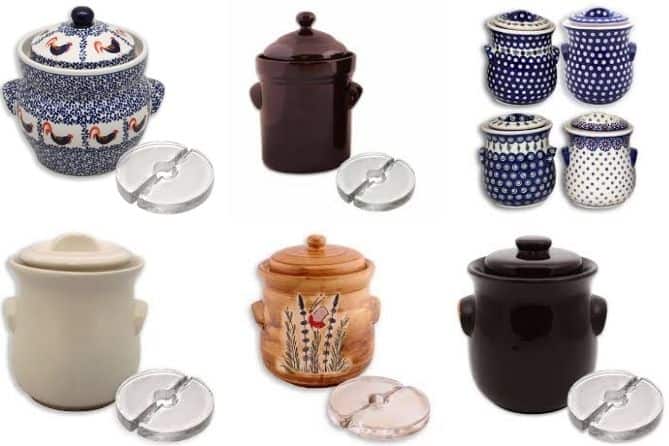
The large variety and styles of crocks sold by the Stone Creek Trading family-owned business are well worth a look. They are handcrafted with the rich, abundant local clay by artisans in the Boleslawiec region of Poland.
Special Perk! The crocks sold by Stone Creek Trading come with lead-free glass weights as an alternative to the traditional porous ceramic weights which are sold with most fermenting crocks. From their website:
With traditional ceramic porous weights, the unglazed surface can absorb bacteria present in your ferment. When something goes wrong in the fermentation process, the bad bacteria or mold can be absorbed into the porous stones. It can be very difficult to then sanitize the porous stones. As an alternative, glass is non-porous and will not absorb anything!
In addition to being non-porous:
Luna Glass Crock Weights are 15% heavier than the traditional porous weights. The additional weight helps keep your ferment submerged where you want it.
I have a detailed review of the 5-liter crock gifted me by Stone Creek Trading. I love using the glass weights and especially like that they don’t absorb odors or stains and allow you to see food beneath.
Also, each crock goes through a thorough quality-control check by Stone Creek before they ship it. If you read the Amazon reviews for the crocks found on Amazon, many arrived cracked or chipped. Buy direct, support a family-owned business, and save that headache.
Ohio Stoneware
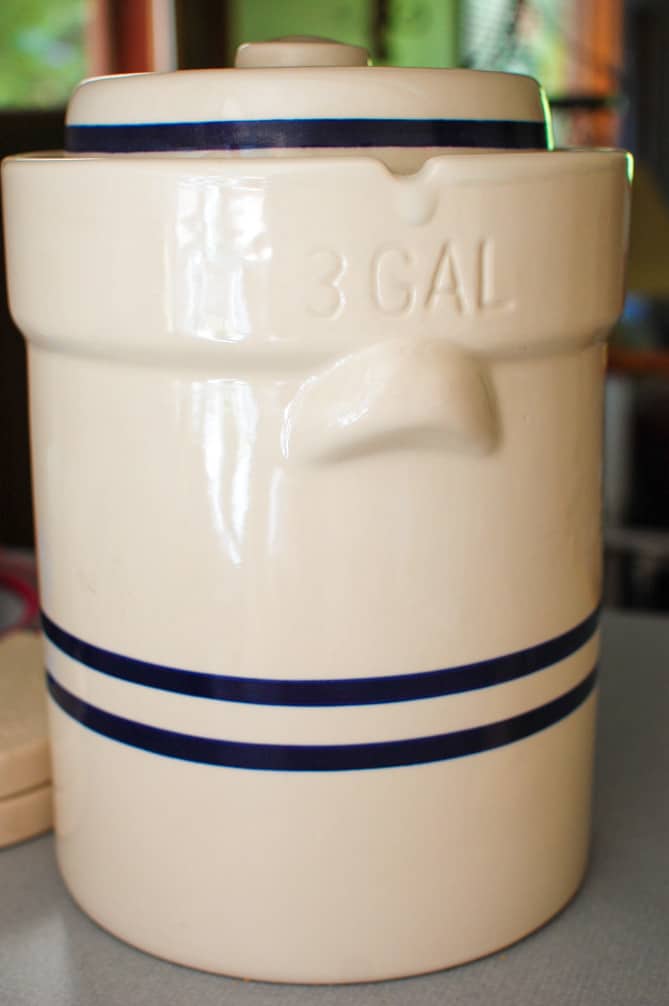
I own this 3-gallon crock made by Ohio Stoneware. It is large, but I love it for those extra-big batches of sauerkraut.
I packed 30 pounds of my Kimchi sauerkraut recipe into this crock last fall. It’s too heavy to lift when full, so I packed it right where it would be fermenting.
The Ohio Stoneware crock has clean, smooth lines. The weights are large and heavy to better hold the ferment below the brine. The crock walls are thinner than with most other ceramic crocks.
GoodtoGoCo [Canada]
The “100% Canadian” GoodtoGoCo carries the Roots & Harvest crock in a variety of sizes. The stone weights are unglazed.
Scythes Australia [Australia]
Hazelcombe Farm imports fermenting crockpots from Zaklady Ceramiczne Boleslawiec, Poland. They are high-quality ceramics made of porcelain clay with a food-safe glaze, guaranteed to be lead and cadmium free.
The crockpots are available in a variety of sizes.
Kitchen Warehouse [Australia]
Kitchen Warehouse in Australia has a small collection of water-sealed crocks.
Mad Millie [New Zealand]
Mad Millie crocks are available from a variety of suppliers in New Zealand, Living & Giving being one of them.
The Mad Millie crock is a 3-liter comes that is shipped with 2 traditional clay weights, and a how-to guide.
Ken Bours Ceramics Agency [Netherlands—Ships Worldwide]
Ken Bours Ceramics Agency is located in the Netherlands and ships worldwide.
They carry a variety of water-sealed fermentation crocks in sizes from 2-liters to 25-liters. Styles vary all the way from the traditional straight-walled to hand-etched rounded. Some are handmade by master Dutch Ceramist Daniel Lebon.
Art that Makes Food: Crocks Handmade by Artisans
Mark Campbell Ceramics

The crocks from Mark Campbell Ceramics are wheel-thrown and made to order with your choice of glaze colors.
Design one to sit on your kitchen counter to daily add beauty to your home and inspire you to make sauerkraut! More about Mark Campbell Ceramics here. Be sure to check out his beautiful bowls.
LISTEN HERE to Mark discussing his business and journey into the fermentation world on The Fermentation Podcast. Show notes include a video of him making a 1-gallon crock and his Taco Kraut recipe.
He totally gets how flavor-packed sauerkraut can dramatically and effortlessly shift the flavor of a meal which is why I’m always creating new recipes.
Sarah Kersten
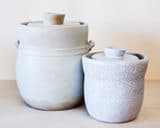
Sarah Kersten modeled her fermentation crocks after a traditional Chinese design. These crocks are designed by Sarah and handcrafted at her studio in Berkeley, California.
Crocks come with glazed porcelain weights and a letter-pressed booklet of recipes and instructions.
Sarah’s work is inspired by her love of beautiful, functional ceramics, and her desire to produce heirloom-quality fermentation crocks.
Other Types of Water-Sealed Fermentation Vessels
Onggi Pot
- Material : Earthenware // Color : Dark Brown Size : Dia 5.82” H 5.23” Mouth Dia...
- Korean Traditional style Earthenware jar-Hangari.
- Optimal size for various sauce paste storage.
Onggi pots are what are normally used to make kimchi. They are traditionally made from clay and sand but are now usually made from ceramic. They are fired in a kiln which leaves them with tiny pores. These tiny pores allow the kimchi inside the pot to breathe while making it watertight to achieve proper fermentation.
Onggi pots can be a bit difficult to find. 9 Best Onggi Pots for Kimchi! gives a nice explanation of their design features and some sources.
Kimchi Fermentation Container
- 1 Pack for 0.9 Gal (3.4L)
- The original sandy brown colored container for foods with strong color
- The Perfect fermentation and storage container combining the ancient Korean Onggi principle...
Crazy Korean Cooking explains how their fermentation containers work. They are available in a large variety of sizes, two shapes, and work quite well.
The container is made from high-quality durable polypropylene plastic mixed with 7-10% natural clay to create very fine pores. This keeps the food fresh while preventing harmful (aerobic) bacteria from thriving.
The simple yet brilliant design of the inner vacuum lid allows easy adjustment of the lid position according to the level of food. The carbon dioxide released by lactic-acid-producing bacteria is absorbed back into the brine, creating a more refreshing taste.
The Crazy Korean Cooking kimchi container’s double lids contain odors better than most containers, preventing them from permeating your home.
Chinese Pickling Crock
- The glass jar is made with healthy glass, a perfect choice for storage and fermenting food....
- The fermentation jar is with 2.5 Liter capacity giving you enough space for homemade pickles,...
- Easy to use. Pour some water around the bowl lid of the glass jarto create an airtight sealing,...
I don’t recommend these glass (which you will also see in ceramic) pickling crocks. The small opening makes them difficult to fill and also a challenge to use any type of fermentation weight.
However, Stone Creek Trading sells a Polish decorated crock that does have weights and a large enough opening.
WHEN to Ferment in a Crock

There are two ways to look at “when” to ferment in a crock: skill level and time of year.
Skill Level
As I said above, you’ll want to be comfortable with fermenting small batches in a jar before you use a large crock.
Mistakes with small batches make for small losses. Success with a jar-sized ferment builds confidence and empowerment. So, first things first:
- Have you made a few jars of sauerkraut using my How to Make Sauerkraut In a Jar [THE COMPLETE GUIDE] recipe? Wonderful!
- Do you feel comfortable making sauerkraut and do you know which flavors your household prefers?
- Do you have a rough idea of how much sauerkraut your family eats?
Yes? Yes? and Yes? Then, select the right-sized crock for your needs and happy fermenting!
Time of Year
The time of year when you ferment a batch of sauerkraut can impact your results.
Any time? You can ferment any time of year that works for you, but you may notice that batches made in the heat of summer turn out softer and almost a bit musty.
When I bought my first crock—a 10-liter Harsch Crock—I made a batch once a month. Just when my family was about to finish our last jar of Dilly-Delight Sauerkraut—the only flavor I made at that time—the next batch was ready to harvest.
So, on my next shopping trip into town, I would purchase 4 or 5 heads of cabbage and get to slicing. With this approach, I was fermenting throughout the year and was able to notice changes in the sauerkraut depending on the temperature I was fermenting at.
Fall (Ideal)? Traditionally, fermentation is a way to preserve the harvest. The best cabbage for fermentation is harvested in the fall (at least in North America), ideally, after a few frosty nights that sweeten the cabbage.
Now that I have not only great local sources for cabbage in the fall but an extra refrigerator to store a year’s supply of sauerkraut, I make the bulk of my sauerkraut seasonally. Nothing beats a fully-stocked refrigerator.
Summer (A challenge)? You’ll want to avoid the peak of summer when temperatures in your home are above 85F (29C). These temperatures are too high for the stages of fermentation to properly unfold.
If temperatures are on the warm side, ferment for a shorter time period, 2 to 3 weeks instead of 4 to 6 weeks, and up your salt concentration a bit.
HOW to Care for Your Crock
Luckily, stoneware crocks are pretty much carefree. There are a few things to be aware of, however.
Inspect Crock and Weights
Once you purchase and receive your beautiful new fermentation crock, take some time to inspect it.
Inspect the crock and weights closely, looking for any damage (cracks, chips, broken handles).
Fill the crock with water and let it sit in your sink for 24 hours to make sure that there are no cracks.
Test the crock by “pinging” it or “flicking” it with your middle finger pulled off your thumb. If it sounds like a bell, the crock is good. If the “ping” is flat, the crock is damaged.
Smooth Out the Edges
Inspect the bottom of your crock carefully running your hand over the bottom.
If you notice some rough edges, here’s a tip left by a potter in the Comments section:
The unglazed edges on the various crocks and lids are often rough enough to scratch a counter. Before using your crock, simply get wet-dry sandpaper (the black stuff) and do 20 seconds with 180, 200, and 220 grit and then 20 seconds with 400 grit under running water and those edges with be super smooth.
Ferment with Crock Raised off the Floor
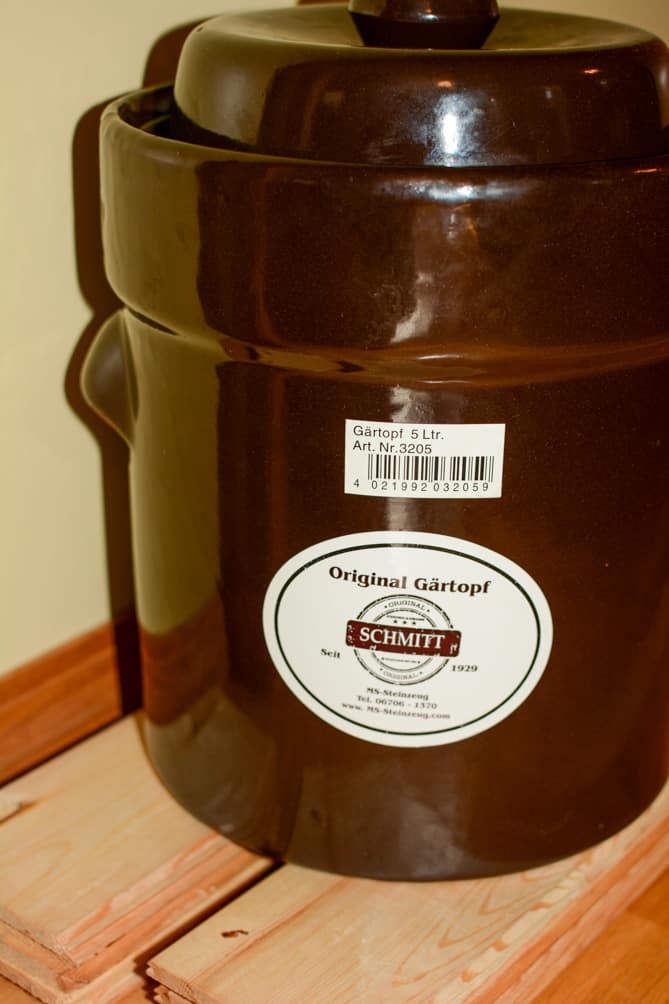
The bottoms of most crocks are not glazed and moisture can transpire through to the floor.
When fermenting with your crock, you’ll want to protect your floor from possible condensation. Raise the crock off the floor with a few blocks of wood.
Make Sure Crock is Clean and Dry Before Storing
Once you are finished fermenting, it’s a good idea to thoroughly clean and completely dry your crock. Use regular dish soap to gently scrub it down, making sure to clean the area up under the water trough. Don’t forget the lid and weights.
Dry parts with a dish towel, then, leave them out separately and in a well-ventilated area to completely dry. If you have unglazed weights, give them a good week to make sure no moisture is retained in them.
Store your crock and weights in an area where they won’t get damp. It doesn’t hurt to put some scrunched-up newspaper in the crock and prop the lid up a tad to allow for better airflow.
Store Weights in a Dry, Well-Ventilated Area
Early on, I stored my unglazed weights in my crock. Bad idea! The next time I opened my crock, I was greeted by mold-encrusted weights.
Weights need to dry in the open air for a good week to make sure there is no longer any moisture left in them. I do this and then store them by themselves in one of my kitchen cabinets.
How to Remove Mold from Your Weights
No matter how careful you are, there may be times when mold does grow on your weights on in the crock. They can be easily cleaned and your precious investment does not need to be tossed.
According to Mark Campbell of Mark Campbell Ceramics, as discussed in this podcast, mold can’t be removed with bleach. He believes all the bleach does is dye the color of the mold; it does not completely remove the mold.
Instead, he recommends cleaning the crock and weights with some vinegar and rinsing thoroughly. Next, put the weights (not the crock) inside a cold oven and then turn the oven on to 250 degrees and let them sit in there for 30 minutes. Turn the oven off and wait for the weights to cool down so that you can remove them with your bare hands.
The heat and the vinegar will kill the mold. Mold is more of an issue with unglazed weights. With glazed weights, it is much easier to just rinse off the mold.
Frequently Asked Questions
That is called “crazing” and allows the brine to seep out. The white film is a salt residue that is visible when the brine dries. I would return a crock with hairline cracks.
The brine just needs to cover the sauerkraut. It is fine if the top of the weights is not covered in brine.
Ideally, you pack a fermentation crock 3/4’s full. This cuts down on the amount of air space left in the crock. The greater the airspace left in the crock, the greater the chance for mold and yeasts to take hold.
No. Just clean with soap and thoroughly rinse.
Which size fermentation crock are you thinking of buying? Know of a company I need to add to the list? Let me know in the comments section. Thank You!
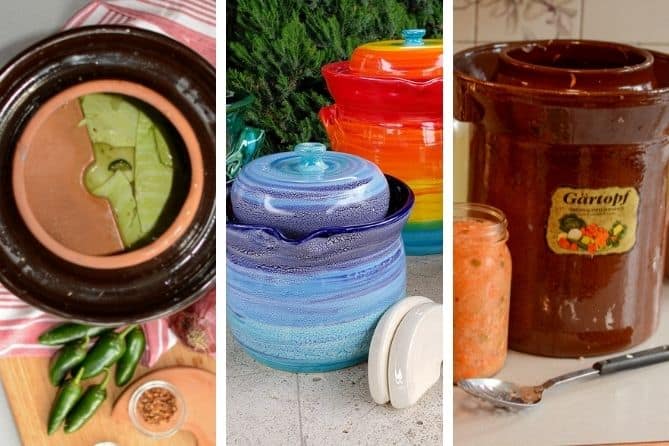
Last update on 2024-07-26 / Affiliate links / Images from Amazon Product Advertising API



 This post may contain affiliate links which won’t change your price but will share some commission.
This post may contain affiliate links which won’t change your price but will share some commission.